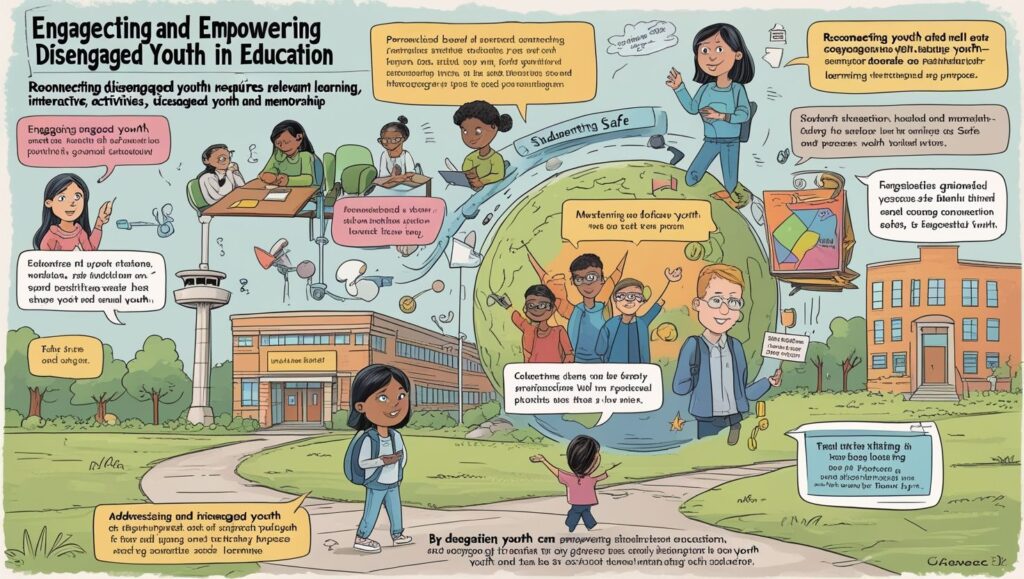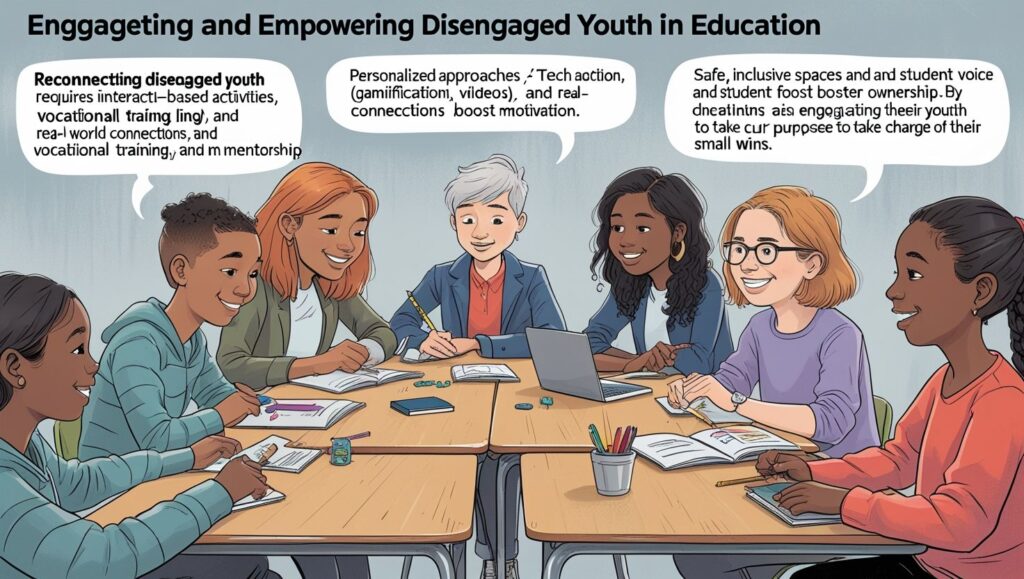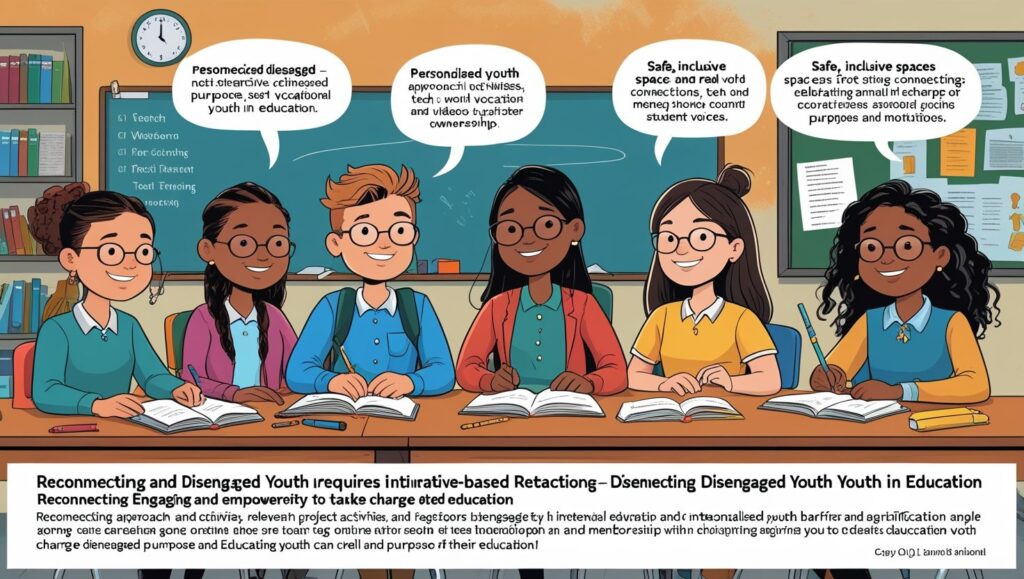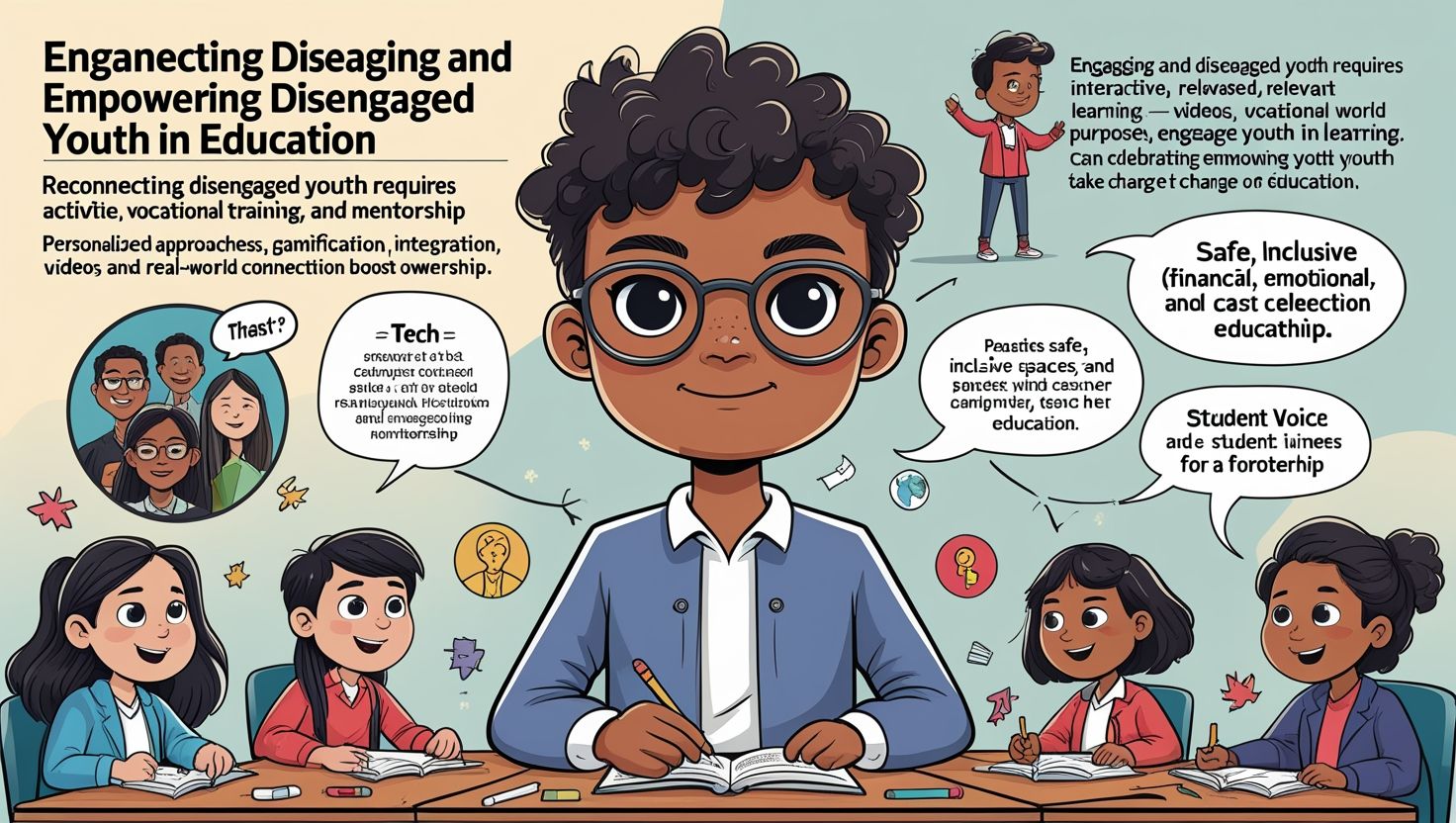Introduction:
Engaging and Empowering Disengaged Youth in Education, Today, disengaged youth are a growing concern in many educational systems. While some students thrive in schools, others lose interest quickly. In fact, a large number of young people feel disconnected from their educational journey. This disengagement often leads to academic failure, dropout, or risky behaviors. Although the reasons are complex, they are not impossible to address.
Furthermore, it is essential to understand what causes disengagement. Often, it stems from a lack of relevance, poor relationships, or personal struggles. Additionally, institutional factors such as rigid curricula and lack of student voice contribute to the issue. Therefore, identifying and addressing these causes is crucial.
However, it is not enough to recognize the problem. Educators must actively seek solutions. They should work collaboratively with parents, communities, and policy makers. Only then can meaningful change take place. Clearly, engagement is more than participation; it involves emotional and cognitive investment.
In conclusion, solving this crisis requires immediate attention. Through tailored strategies, educators can reconnect with disengaged youth. If efforts are sincere and student-centered, they will succeed. Therefore, this article explores key methods to engage and empower such students for lasting educational success.
Understanding the Roots of Disengagement
First, we must understand why students become disengaged. Several factors often combine to push youth away from education. For example, socio-economic challenges, family issues, and peer pressure can play major roles. In addition, low self-esteem and repeated academic failures also contribute significantly.
Moreover, some students feel that the curriculum does not relate to their lives. As a result, they lose motivation. Often, their talents lie outside traditional subjects. Despite this, schools may not recognize or support their strengths. In such cases, students feel ignored and undervalued. Therefore, they begin to disconnect emotionally.
In some instances, teacher-student relationships lack warmth or encouragement. When students feel misunderstood, they retreat further. Additionally, schools that focus heavily on standardized testing often limit creativity. Consequently, students feel trapped in systems that do not support their individuality.
Furthermore, digital distractions and poor mental health are rising concerns. Young people today face overwhelming social media pressures. Unfortunately, schools are slow to adapt to these realities. Thus, disengagement grows steadily.
To reverse this trend, it is important to listen to students’ voices. We must understand their needs, interests, and struggles. Without this insight, engagement strategies will fall short. Therefore, the journey begins with empathy and understanding.

Building Trusting Relationships with Students
Strong relationships are the foundation of student engagement. When students feel valued, they respond positively. Therefore, teachers must focus on building trust with their students. Although content is important, connection matters even more.
To begin with, showing genuine interest makes a difference. Teachers who learn about students’ backgrounds, hobbies, and dreams can better connect. In turn, students are more likely to listen, participate, and excel. Additionally, respectful communication sets a positive tone in the classroom.
Moreover, consistency and fairness build credibility. When students know what to expect, they feel secure. This emotional safety encourages participation. Furthermore, empathy goes a long way. Students who face personal struggles need understanding, not judgment.
In addition, peer relationships should not be ignored. Promoting teamwork and inclusion helps reduce feelings of isolation. When students feel part of a group, they are less likely to disengage. Therefore, fostering a positive classroom culture is essential.
At the same time, involving parents can strengthen trust. When families and schools work together, students benefit more. In conclusion, strong relationships foster motivation. With compassion and care, teachers can truly re-engage their students.
Creating Relevant and Practical Learning Experiences
Education must feel meaningful to engage students. When learning connects with real life, students pay attention. Unfortunately, many school lessons feel abstract and disconnected. Therefore, making education relevant is essential for motivation.
To begin with, teachers should relate lessons to students’ lives. For example, math can include budgeting or career planning. Similarly, science lessons can explore environmental issues in their community. These methods spark curiosity and interest.
Moreover, offering project-based learning creates deeper understanding. When students solve real problems, they feel a sense of purpose. Furthermore, practical tasks like presentations, experiments, and field visits add excitement. These experiences are more engaging than lectures alone.
Additionally, incorporating technology can boost relevance. Today’s youth are digital natives. Therefore, using apps, simulations, and videos makes learning feel current. However, balance is key. Technology should support learning, not distract from it.
Involving students in curriculum design is another smart step. When they choose topics or projects, their commitment increases. Furthermore, career-focused education helps students see future possibilities. As a result, they find reasons to stay engaged.
Ultimately, making learning practical and personalized transforms classrooms. Students begin to see education as a tool, not a burden. Therefore, relevance must be a guiding principle in modern education.

Promoting Student Voice and Leadership
Students must feel heard to remain engaged. When they have no say, they often feel powerless. Consequently, offering students opportunities to express opinions boosts motivation. Student voice is not a luxury—it is a necessity.
To begin with, classroom discussions should encourage open dialogue. Teachers can ask for feedback about lessons, activities, and classroom rules. This inclusion makes students feel respected. As a result, they participate more actively.
Moreover, schools should create student leadership roles. For instance, student councils, class representatives, and peer mentors foster responsibility. These positions allow students to influence decisions that affect their lives. Therefore, they become more invested in school culture.
Additionally, encouraging students to lead projects increases confidence. Whether organizing a campaign or starting a club, such activities build self-worth. They also improve teamwork, planning, and communication skills.
Furthermore, listening to student complaints respectfully shows maturity. When schools take feedback seriously, students respond with trust. Although not every suggestion can be implemented, every voice deserves to be heard.
In short, empowerment fuels engagement. When students are treated as partners, not passive recipients, their attitudes change. Therefore, student voice and leadership must be prioritized in every school environment.
Supporting Mental Health and Emotional Wellbeing
Mental health plays a major role in student engagement. Youth who struggle emotionally cannot focus on academics. Therefore, schools must support students’ mental wellbeing actively. This is not just helpful—it is essential.
To begin with, recognizing signs of stress and anxiety is crucial. Teachers should receive training to identify these issues. Additionally, school counselors should be easily accessible to students. Without mental health support, disengagement will persist.
Moreover, schools should create safe spaces for expression. Group activities, peer support clubs, and mindfulness sessions help students open up. In these settings, they feel less judged and more understood.
Furthermore, reducing academic pressure helps ease mental strain. For instance, flexible deadlines and alternative assessments accommodate diverse needs. As a result, students feel less overwhelmed.
Building a culture of kindness and empathy also promotes wellbeing. Bullying, exclusion, and harsh discipline can deeply damage a student’s mindset. Therefore, positive behavior programs and peer mediation should be encouraged.
In addition, involving parents in mental health discussions strengthens support. When home and school work together, interventions are more effective.
Ultimately, supporting mental health is not optional. If students feel emotionally safe, they can fully engage. Therefore, wellbeing must be embedded in every educational setting.
Leveraging Technology for Reconnection
Technology can either distract or engage youth. When used wisely, it becomes a powerful tool for reconnection. Therefore, integrating digital tools into learning strategies can reignite student interest.
First, online platforms offer flexibility. Some students struggle with fixed schedules. With digital learning, they can access lessons at their own pace. As a result, they regain control over their learning journey.
Moreover, gamified learning increases motivation. Educational games, quizzes, and interactive videos make learning fun. These tools hold attention better than traditional lectures. Additionally, they cater to various learning styles.
Furthermore, virtual collaboration enhances peer connection. Online group projects, forums, and chats build community among students. Even those who are shy in class can participate comfortably online.
Also, technology helps track progress effectively. Real-time feedback allows students to improve quickly. Teachers can also personalize content based on student needs. Therefore, learning becomes more tailored and efficient.
However, access remains a challenge. Schools must ensure that all students have digital tools. Equity is essential in digital education.
In summary, technology offers multiple paths to re-engagement. When blended thoughtfully, it meets students where they are. Therefore, schools must embrace digital innovation for lasting impact.

Involving Families and Communities
Engaging youth requires a team effort. Families and communities play key roles in supporting education. When these groups collaborate with schools, students benefit more.
To begin with, parents must stay involved in their children’s learning. Regular communication between home and school strengthens understanding. Parent-teacher meetings, online portals, and calls keep everyone informed. As a result, issues are addressed early.
Moreover, involving parents in school activities builds trust. Workshops, volunteering, and family nights create a sense of belonging. When families feel welcome, students feel supported.
In addition, community members offer real-world learning. Local experts, artists, and professionals can mentor students. These connections show how school links to careers and life. Therefore, learning feels purposeful.
Furthermore, businesses and organizations can offer internships or sponsorships. These opportunities boost student motivation. They also help schools provide more resources and experiences.
Also, cultural events and local projects foster unity. Celebrating heritage and diversity makes students proud of their identity. As a result, they feel more connected to school.
Ultimately, education must extend beyond school walls. When families and communities partner with educators, disengaged youth feel surrounded by care. Therefore, collaboration is key to re-engagement.
Policy and System-Level Changes
Systemic changes are necessary to support student engagement. Although individual teachers can do much, long-term change requires strong policies. Therefore, governments and education leaders must act.
To begin with, curricula should become more flexible. Rigid, test-heavy systems often discourage creativity. Instead, schools need learner-centered approaches. These promote critical thinking and real-world skills.
Moreover, funding must support inclusive education. Programs for mental health, career guidance, and extracurriculars require investment. Without resources, engagement strategies remain limited.
Additionally, teacher training must prioritize engagement techniques. Educators need skills to handle diverse classrooms. Emotional intelligence, active learning, and trauma-informed teaching should be central in training programs.
Further, dropout prevention policies must be enforced. Early warning systems help identify at-risk students. Timely interventions then prevent long-term disengagement.
Also, schools should be evaluated on student wellbeing, not just test scores. Metrics like attendance, participation, and satisfaction offer better insight into school success.
In conclusion, lasting change requires strong foundations. Policy must align with classroom realities. Therefore, education systems must evolve to meet the needs of modern youth. Only then can disengagement be reduced at scale.
Conclusion: A Collective Commitment
Engaging disengaged youth is a shared responsibility. It involves listening, supporting, and adapting. Although the challenge is great, the cost of inaction is greater. Therefore, schools must act decisively.
First, understanding student struggles is essential. Without empathy, strategies will fail. Additionally, strong relationships create safety and trust. They form the heart of engagement.
Moreover, making learning relevant and giving students a voice empowers them. With purpose and ownership, students begin to re-engage. Mental health support and digital tools further strengthen this process.
Involving families and communities builds a wider safety net. Students need support from all directions. At the same time, systems must provide the structure and resources for change.
Ultimately, youth are not lost—they are waiting to be reached. With effort, patience, and compassion, educators can inspire them again. Although the journey is long, it is worth every step.
Therefore, let us commit to empowering every learner. In doing so, we secure not only their future—but our collective one as well.

yn56ij
e8ljaa
Hey there, You’ve performed an incredible job. I will certainly digg it and individually recommend to my friends. I am sure they’ll be benefited from this web site.
Platform Slot Gacor yang Membayar Besar dan Tepat Waktu, hanya di SIGMASLOT
Wonderful work! This is the type of info that should be shared around the internet. Shame on the search engines for not positioning this post higher! Come on over and visit my website . Thanks =)
I like this site because so much useful material on here : D.
z5jmfi
31719a
3zjot0
a7bqvk
w80jry
288cv0
Very interesting information!Perfect just what I was searching for!
Hi there, You’ve done an incredible job. I will definitely digg it and personally suggest to my friends. I’m sure they’ll be benefited from this site.
When someone wries an paragraph he/she keeps thee plan of a user
in his/her brain that how a user can know it. Thus that’s why this pparagraph is perfect.
Thanks! https://fortune-Glassi.Mystrikingly.com/
You are a very bright person!